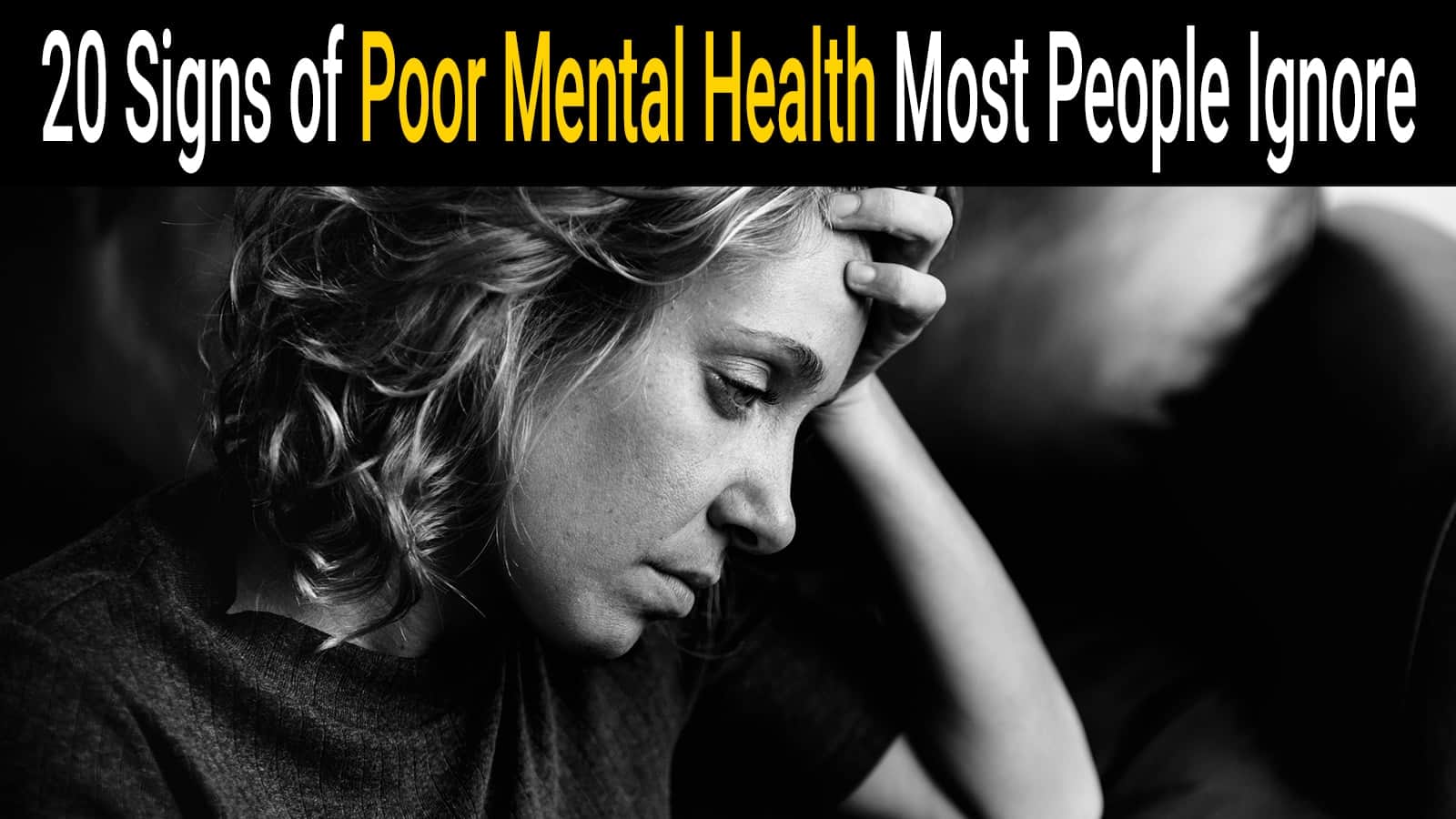The issue of mental health has increasingly been hitting the headlines. We have been reading more and more articles related to celebrities committing suicide, mass shootings, and the general rate of suicides on the rise. More children are being diagnosed with ADHD, depression, anxiety and pediatric bipolar disorder. Awareness should be higher than ever, so how is the image of declining mental health still allowing society to turn a blind eye? In examining the definition, the history, stigma, and unsuspected symptoms, it is possible to theorize why we turn a blind eye to mental illness.
How prevalent is poor mental health in our society?
Per the National Institute of Mental Health, 1 in 5 adults live with mental illness.
Note: AMI refers to Any Mental Illness as opposed to specifically Serious Mental Illness.
- In 2017, there were an estimated 46.6 million adults aged 18 or older in the United States with AMI. This number represented 18.9% of all U.S. adults.
- The prevalence of AMI was higher among women (22.3%) than men (15.1%).
- Young adults aged 18-25 years had the highest prevalence of AMI (25.8%) compared to adults aged 26-49 years (22.2%) and aged 50 and older (13.8%).
- The prevalence of AMI was highest among the adults reporting two or more races (28.6%), followed by White adults (20.4%). The prevalence of AMI was lowest among Asian adults (14.5%).
Definition of Poor Mental Health – Part of the Confusion?
According to Merriam-Webster, mental illness is defined as the following:
“any of a broad range of medical conditions that are marked primarily by sufficient disorganization of personality, mind or emotions to impair normal psychological functioning and cause marked distress or disability and that are typically associated with disruption in normal thinking, feeling, mood, behavior, interpersonal interactions and daily functions [such as major depression, schizophrenia, obsessive compulsive disorder, or panic disorder].”
Issues with the Definition
Just in reading this definition alone, you probably note a vagueness and inability to associate or connect with the behaviors considered symptoms of mental health illnesses. Of course, symptoms will vary depending on the diagnosis and severity of the illness.
The second issue with the definition is that it does not give a range of the intensity of the symptoms. It gives the image of someone with very obvious symptoms, such as an individual unable to eat, speak to people in public in an accepted manner, hold down a job, go to school, drive a car, handle a family and responsibilities, and more. However, most people with mental problems can still carry out day-to-day tasks, even if they struggle through them. People around them may just label them as “moody,” “having anger issues,” “anti-social,” “not highly motivated,” “unfocused,” “lacking in discipline,” “ a little odd,” “over-emotional,” “high-strung,” or that they “just need a drink to calm their nerves.” The list could go on and on. Many symptoms of mental illness that are now professionally recognized might have previously been “excused” behaviors for our loved ones or people we have met.
As a third note, the dictionary goes on to mention a few disorders, such as schizophrenia, that still have a strong stigma attached to them. Unfortunately, those who don’t have a mental illness often look at these disorders as something the sufferer brought on themselves.
While the definition’s vagueness helps it broadly define a wide variety of symptoms for a multitude of disorders, it does not aid in the general public’s understanding.
Brief History of Mental Health Issues
Mental illness is not new to society and the human populace. It simply had a different name throughout centuries past. In the past, many cultures viewed it with a religious or superstitious nature. Essentially, most people considered lower-functioning individuals as possessed by evil spirits, falling out of God’s grace, practicing witchcraft, and more. Treatments for these individuals were torturous. It was believed that, of course, they must banish the evil, which usually involved isolating the individual, physical abuse, torturous handling, and more. At one time, some practiced drilling a hole in the sufferer’s head, believing it would release the “bad elements.”
While Hippocrates, in 500 BC, pioneered the idea of treating the mentally ill with medications and removing them from their jobs or living situations, the amount of medical information was clearly inadequate. Sadly, most of the medications consisted of opiates to keep them calm.
Mental Illness and Women
Women overall have had the worst stigma associated with mental illness. What was being labeled as mental illness was often hormonal imbalances which caused women to be more emotional, reactive, anxious, and depressed. To further complicate things, the manner of dress inflicted on women – primarily the corset – restricted the ability to breathe as well as the proper settling of internal organs. This created pain, difficulty breathing, back issues, and other symptoms labeled as panic attacks. Most people believed that women were just weak of heart and nerves.
It was not until the 18th century that America started addressing the need for proper living conditions for the mentally ill. Not until the 1900s did people start to push for a proper understanding and treatment of these illnesses. Due to this great delay in recognition, research and study, centuries-old stigmas remain to this day. Fortunately, this stigma is now getting recognized in the public through celebrities speaking out.
Functioning Mental Illness
“There’s no look to mental illness.” – Project Helping
For years, centuries even, there has been an idea of what a highly depressed, anxious, schizophrenic, or bipolar person looks like. There is usually the image of strange ramblings, odd statements, poor grooming, and a disheveled appearance. Or perhaps you have a mental image of someone with a “wild look in the eye” or always looking down at the ground. People might think those with mental illness loudly display their emotions, and so on. The fact is, many people have a functioning mental illness. They may or may not take medication; to meet them briefly or as an observer from a distance, they appear just fine. They are intelligent, well-spoken, dressed and groomed appropriately, financially secure, and employed. In other words, they have all the expected societal behaviors of a “well-adjusted” individual.
Funny, that word “well-adjusted.” They have adjusted well to coping with their symptoms of depression, anxiety, compulsions, mood swings, phobias, or whatever form their mental illness takes. Human beings are amazingly adaptive creatures and mental illness does not change this. Many people with mental illness turn to religion, meditation, visualization, exercise, adjusting their schedules, and accepting jobs that can accommodate what they know to be their symptoms.
They take proactive measures to help themselves by reading articles that address their symptoms and alternative behaviors. Yet, while they have learned to function, they may still fight hidden symptoms. Additionally, they likely find their symptoms difficult to discuss or find alternatives for.
Here are 20 signs of poor mental health most people ignore:
- Continued mood swings
- Social anxiety or isolation
- Sweating a lot (or feeling very cold)
- Sensitivity to noise, crowds, too much stimulus
- Low frustration or tolerance levels leading to angry outbursts
- Fluctuating sex drives from high to low
- Scars from self-harm
- Sleep difficulties – either feeling excessively tired even with sleep or unable to sleep
- Increased heart rates leading to dizziness, weakness
- Panic attacks
- Muscle weakness or tension
- Overthinking
- Difficulty making a decision
- Poor self esteem
- Perfectionist – feel they cannot make a mistake
- Difficulty with consistency of work performance
- Negative thinking
- Vomiting in anxiety-producing environments
- Continued feelings of inadequacy
- Fear of rejection
Some people who battle such demons find that humor helps get them through it. Memes or comics are a great way to get a different perspective on mental illness as well as educate others about the symptoms people deal with on a daily basis. Reaching out to someone and trying to understand can mean the world to someone battling this hidden war. It’s important to understand that just because a person appears “well-adjusted” doesn’t mean they don’t still have a mental illness. It just means that they have created a system to limit the effect it has on their lives. All survivors have this in common.
Closing Thoughts
The subject of Mental health is diverse and can be pervasive or subtle in its symptoms. It is a dysfunction of the brain in most cases and an actual disease in others. If 1 in 5 people have a mental illness, then chances are, someone you know has an illness even if you are completely unaware of it. The diversity of symptoms aids in lack of awareness. The stigma placed on a mentally ill person also plays a part. Additionally, society has learned to excuse behaviors that don’t fit the norm so long as they’re not seen as immediately dangerous. All of these factors combine to result in people turning a blind eye to unsuspecting symptoms of mental illness.
If you or someone you know suffers from poor mental health, please seek professional help. There are plenty of resources available for anyone struggling with a mental disorder.




















